Conosciamo la sensazione. Quel momento di sconforto in cui il vostro sito va giù e non avete idea del perché. È uno degli errori più comuni di WordPress, ma anche uno dei più misteriosi. Non vi dice cosa c’è che non va, ma solo che qualcosa è rotto.
La buona notizia? È quasi sempre risolvibile. Avendo aiutato innumerevoli personalizzati, abbiamo avuto a che fare con questo errore molto spesso.
In questa guida vi illustreremo i passaggi esatti per ripristinare il vostro sito e renderlo funzionante. Seguiteci e vedrete che tutto tornerà a funzionare in pochissimo tempo.
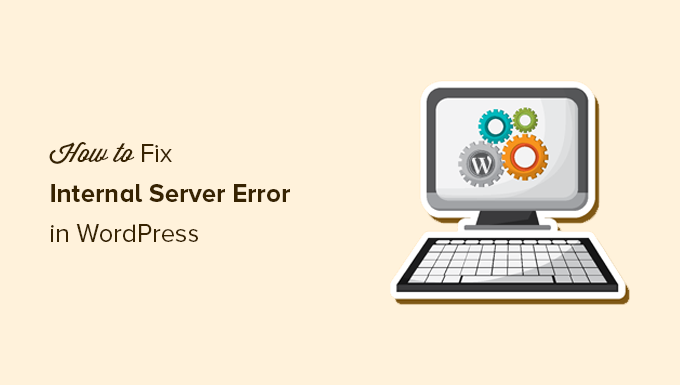
Ecco una rapida panoramica degli argomenti che tratteremo in questo articolo:
- What Is the 500 Internal Server Error?
- What Causes the Internal Server Error in WordPress?
- Fixing the 500 Internal Server Error in WordPress
- Clear WordPress and Browser Cache
- Checking for Corrupt .htaccess File
- Increasing the PHP Memory Limit
- Deactivate All WordPress Plugins
- Switch to a Default WordPress Theme
- Re-Uploading Core Files
- Enable Debug Logs in WordPress
- Ask Your Hosting Provider
- Video Tutorial
Che cos’è l’errore 500 Internal Server?
L’errore 500 Internal Server è come una porta bloccata senza chiave. Si sa che qualcosa non va, ma non c’è una nota che spieghi cosa è successo.
Questo errore non riguarda solo WordPress. Può apparire su qualsiasi sito web quando il server incontra un problema che non sa come gestire.
Il “500” nel messaggio è un codice di stato HTTP. Se lo cercate, troverete una definizione vaga:
“Il codice di risposta 500 Internal Server Error indica che il server ha incontrato una condizione inaspettata che gli ha impedito di soddisfare la richiesta”.
Non è molto utile, vero? È il modo in cui il server dice: “Si è rotto qualcosa, ma non sono sicuro di cosa”.
L’aspetto di questo errore dipende dalla configurazione dell’host e dal browser. Ecco un esempio di come appare su un server Apache:
Se il sito viene eseguito su Nginx, l’aspetto potrebbe essere leggermente diverso. Se Google Chrome non riesce a caricare una pagina di errore corretta, si vedrà qualcosa di simile:
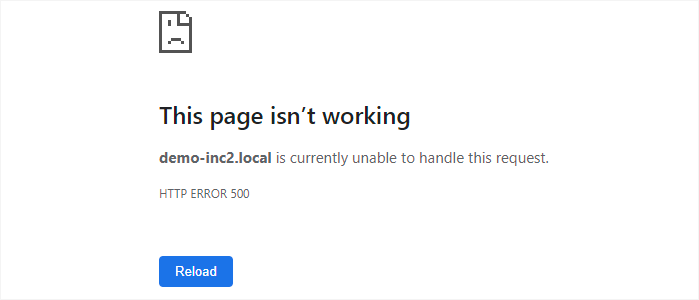
Per i principianti, questa situazione può risultare sconvolgente. Non c’è alcun messaggio che indichi cosa è andato storto o come correggerlo.
È come chiedere a un meccanico di correggere la vostra auto senza dirgli cosa è rotto. Dovranno controllare diverse parti fino a trovare il problema.
In base alla nostra esperienza, il modo migliore per correggere il problema è procedere passo dopo passo. Vi illustreremo le cause e le soluzioni più comuni per far sì che il vostro sito torni a funzionare.
Ottenete l’aiuto di un esperto in qualsiasi momento con il supporto WordPress on-demand!
Affrontare un errore interno del server può essere frustrante. Il nostro Supporto WordPress On-Demand è qui per aiutarvi a correggere i problemi tecnici in modo rapido ed efficace.
- Pagamento unico per l’assistenza on-demand di un esperto
- Tempi di consegna rapidi
- Disponibile 24 ore su 24, 7 giorni su 7
👉 O ttenete subito un supporto di emergenza per WordPress! 🛠️
Cosa causa l’errore interno del server in WordPress?
L’errore interno del server in WordPress è come un puzzle con pezzi mancanti. Sapete che qualcosa non va, ma il messaggio di errore non vi dice esattamente dove si trova il problema.
In base alla nostra esperienza, il colpevole più comune è un file .htaccess corrotto. A volte, si tratta di un plugin che si comporta male o di un tema che non funziona bene con la vostra configurazione.
Altre volte, il sito può colpire il limite di memoria PHP, causando il blocco di WordPress. Anche i file del core corrotti possono innescare questo errore, lasciandovi bloccati senza attenzione.
In alcuni casi, l’errore appare solo quando si cerca di accedere all’area di amministrazione di WordPress, mentre il resto del sito funziona correttamente. È come essere bloccati in casa propria mentre gli ospiti possono ancora entrare dalla porta sul retro.
Ciò che rende questo errore complicato è che di solito si verifica prima che WordPress possa essere caricato correttamente. Ciò significa che il server non può raccogliere abbastanza dettagli per spiegare cosa è andato storto.
Se volete dare un’occhiata più approfondita al funzionamento di WordPress dietro le quinte, consultate la nostra guida su come WordPress opera sotto il cofano.
Passiamo ora alla risoluzione dei problemi per ripristinare il funzionamento del sito.
Risolvere l’errore 500 Internal Server in WordPress
Prima di iniziare la risoluzione dei problemi, assicuratevi di avere a portata di mano un backup completo di WordPress del vostro sito web.
Se avete accesso all’area di amministrazione di WordPress, potete utilizzare un plugin di backup per WordPress per creare un backup completo del vostro sito web.
Per questo consigliamo di utilizzare Duplicator. Non solo vi aiuta a eseguire rapidamente il backup del vostro sito web, ma potete anche archiviare i vostri backup sul cloud e, soprattutto, potete ripristinare il vostro sito web dal backup.
D’altra parte, se non avete accesso all’area di amministrazione di WordPress, potete creare manualmente un backup di WordPress utilizzando phpMyAdmin e un client FTP.
In seguito, potete seguire i seguenti passaggi per risolvere il problema e risolvere l’errore del server interno sul vostro sito web.
Cancellare la cache di WordPress e del browser
I browser e i plugin di caching di WordPress possono talvolta memorizzare erroneamente una copia in cache di una pagina di errore.
Il modo più semplice per risolvere il problema è cancellare la cache del browser.
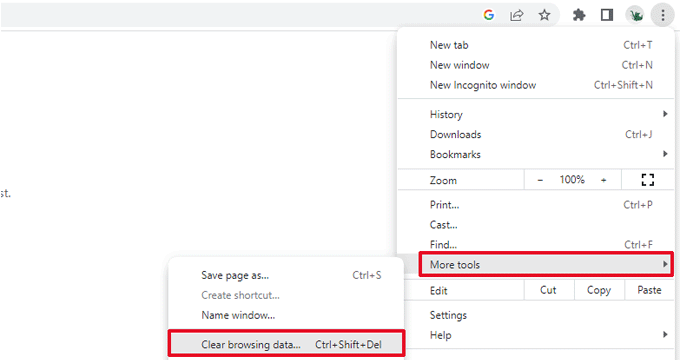
Dopodiché, se avete accesso all’area di amministrazione di WordPress del vostro sito web, potete svuotare la cache di WordPress visitando la pagina delle impostazioni del vostro plugin di caching.
Per maggiori dettagli, consultate il nostro tutorial su come cancellare la cache di WordPress.
Verifica della presenza di un file .htaccess corrotto
Il file .htaccess è un file di configurazione del server utilizzato da WordPress per impostare i reindirizzamenti.
Una delle cause più comuni di errore interno del server è il file .htaccess corrotto.
Il modo più semplice per correggere questo problema è semplicemente visitare la pagina Impostazioni ” Permalinks nell’area di amministrazione di WordPress e poi fare clic sul pulsante “Salva modifiche” senza apportare alcun cambiamento.
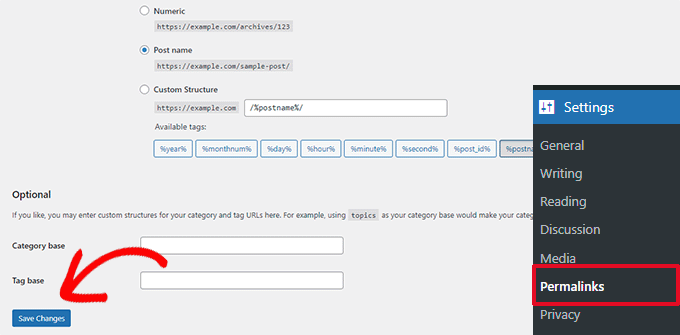
WordPress cercherà ora di aggiornare il file .htaccess o di generarne uno nuovo. Ora è possibile visitare il sito web per verificare se l’errore del server interno è stato corretto.
Se l’errore è ancora visibile, è necessario assicurarsi che WordPress sia stato in grado di generare o scrivere sul file .htaccess.
A volte, a causa delle autorizzazioni di file e directory, WordPress potrebbe non essere in grado di creare o scrivere sul file .htaccess.
Ora potete provare a sostituire il file .htaccess manualmente. Per prima cosa, dovete accedere al vostro sito web utilizzando l’FTP o l’applicazione File Manager nel pannello di controllo del vostro account di hosting.
Successivamente, è necessario rinominare ilfile .htaccess principale in qualcosa come .htaccess_old. Questo vi consente di mantenere il file come backup, ma WordPress non lo riconoscerà.
Per rinominare il file .htaccess, dovrete accedere al vostro sito utilizzando l’FTP o l’applicazione File Manager nel cruscotto del vostro account di hosting.
Una volta collegati, il file .htaccess si troverà nella stessa directory in cui sono presenti cartelle come wp-content, wp-admin e wp-includes.
È sufficiente fare clic con il tasto destro del mouse sul file .htaccess e rinominarlo in .htaccess_old.
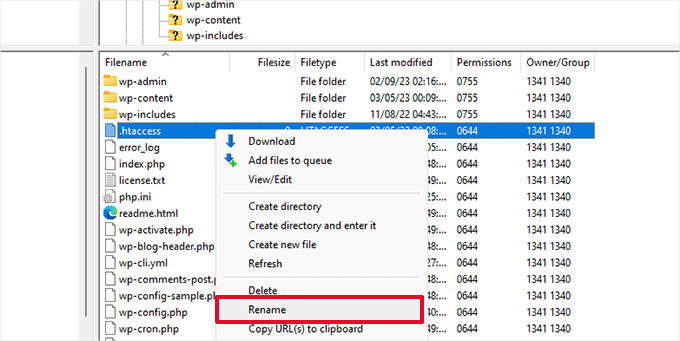
Successivamente, è necessario creare un nuovo file .htaccess.
All’interno della cartella principale del sito, fare clic con il tasto destro del mouse e selezionare l’opzione “Crea nuovo file” nel client FTP o nell’applicazione File Manager.
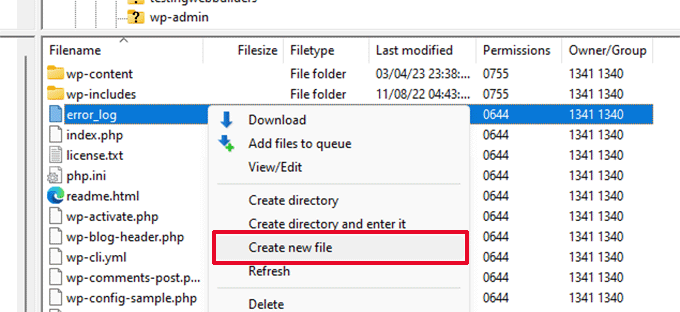
Nominate questo nuovo file .htaccess e fate clic su “OK” per salvarlo.
Ora, questo file .htaccess è attualmente vuoto ed è necessario aggiungervi le regole di riscrittura predefinite di WordPress.
È sufficiente fare clic con il tasto destro del mouse sul file e selezionare “Visualizza/Modifica” nel client FTP o nell’applicazione File Manager.
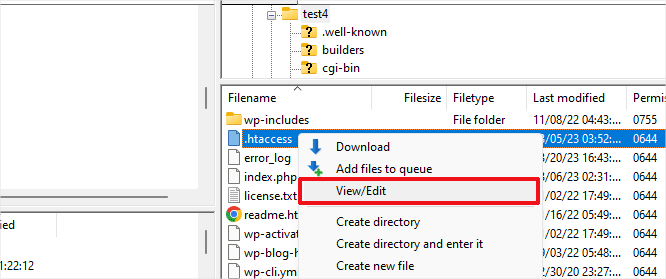
Il file vuoto si aprirà in un editor di testo semplice come Notepad o TextEdit.
A questo punto, è necessario copiare e incollare il seguente codice al suo interno:
1 2 3 4 5 6 7 8 9 10 | # BEGIN WordPress<IfModule mod_rewrite.c>RewriteEngine OnRewriteBase /RewriteRule ^index.php$ - [L]RewriteCond %{REQUEST_FILENAME} !-fRewriteCond %{REQUEST_FILENAME} !-dRewriteRule . /index.php [L]</IfModule># END WordPress |
Questo codice è il set di regole predefinito utilizzato da WordPress. Non dimenticate di salvare le modifiche e di caricare il file sul server.
Ora è possibile visitare il sito web per verificare se l’errore del server interno è stato risolto.
In caso affermativo, allora datevi una pacca sulla spalla perché avete risolto l’errore interno del server.
Importante: prima di procedere con altre operazioni, assicuratevi di andare alla pagina Impostazioni ” Permalinks nell ‘area di amministrazione di WordPress e di fare clic sul pulsante Salva senza apportare alcuna modifica. In questo modo il file .htaccess verrà rigenerato con regole di riscrittura adeguate per garantire che le pagine dei vostri post non restituiscano un errore 404.
Se la soluzione per verificare la presenza di un file .htaccess corrotto non ha funzionato, allora dovete continuare a leggere questo articolo.
Aumentare il limite di memoria di PHP
A volte, l’errore interno del server può verificarsi se uno script consuma tutto il limite di memoria di PHP.
Il modo più semplice per aumentare il limite di memoria di PHP è modificare il file wp-config.php. Se siete principianti, fate attenzione a questa operazione. Seguite attentamente queste istruzioni, perché anche piccoli errori nei file principali di WordPress possono danneggiare il vostro sito.
Per iniziare, è sufficiente collegarsi al proprio sito web WordPress utilizzando un client FTP o l’applicazione File Manager nel pannello di controllo del proprio account di hosting.
Il file wp-config.php si trova nella cartella principale del vostro sito web. Fate clic con il tasto destro del mouse su di esso e selezionate “Scarica”. In questo modo vi assicurerete di avere un file di backup nel caso in cui qualcosa vada storto.
Una volta salvato, è possibile fare clic con il pulsante destro del mouse e selezionare “Visualizza/Modifica”.
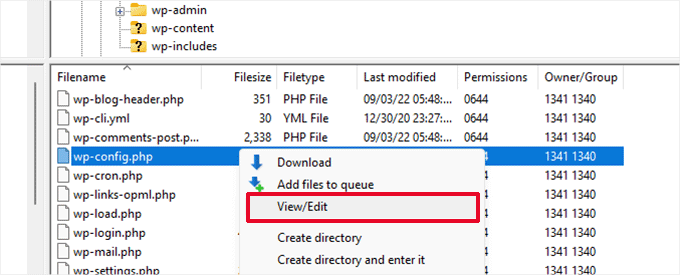
All’interno del file wp-config.php, è necessario aggiungere il seguente codice appena sopra la riga che recita: “Questo è tutto, smettete di modificare! Buona pubblicazione”:
1 | define( 'WP_MEMORY_LIMIT', '256M' ); |
Per maggiori dettagli, consultate il nostro tutorial su come aumentare il limite di memoria PHP in WordPress.
Nota: se 256M non risolve il problema, provare ad aumentare a 512M.
Se l’errore del server interno viene visualizzato solo quando si tenta di accedere all’amministrazione di WordPress o di caricare un’immagine in wp-admin, allora è necessario aumentare il limite di memoria seguendo questi passaggi:
- Creare un file di testo vuoto sul computer e chiamarlo php.ini.
- Incollare questo codice: memoria=256MB
- Salvare il file
- Caricate il file nella cartella /wp-admin/ tramite FTP.
Se l’aumento del limite di memoria ha risolto il problema, allora il problema è stato risolto solo temporaneamente. È ancora necessario trovare la causa che sta esaurendo il limite di memoria.
Potrebbe trattarsi di un plugin mal codificato o anche di una funzione del tema. Vi consigliamo vivamente di chiedere alla vostra società di web hosting WordPress di esaminare i log del server per aiutarvi a trovare la diagnostica esatta.
Se l’aumento del limite di memoria di PHP non ha corretto il problema, è necessario risolvere altri problemi.
Disattivare tutti i plugin di WordPress
Se nessuna delle soluzioni precedenti ha funzionato, è molto probabile che l’errore sia causato da un plugin specifico installato sul vostro sito web.
È anche possibile che si tratti di una combinazione di plugin che non funzionano bene tra loro.
Se potete accedere all’area di amministrazione di WordPress del vostro sito web, potete semplicemente andare alla pagina dei plugin e disattivare tutti i plugin di WordPress.
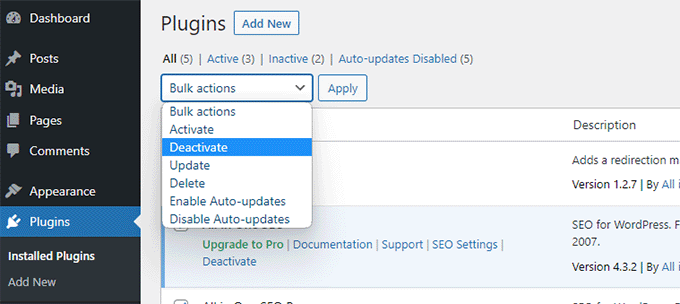
Tuttavia, se non riuscite ad accedere all’area di amministrazione di WordPress, potete disattivare tutti i plugin di WordPress utilizzando l’FTP.
È sufficiente collegarsi al proprio sito Web WordPress utilizzando un client FTP o l’applicazione di gestione dei file nel pannello di controllo del proprio account di hosting.
Una volta collegati, navigare nella cartella /wp-content/ e rinominare la cartella plugins in plugins.deactivated.
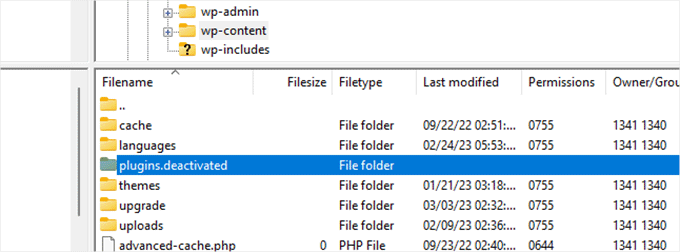
WordPress cerca i plugin nella cartella plugins. Se la cartella plugins non viene trovata, disattiverà automaticamente tutti i plugin.
Ora potete provare a visitare il vostro sito web per verificare se questo ha risolto l’errore del server interno sul vostro sito web.
Per ripristinare tutti i plugin, è sufficiente rinominare la cartella ‘plugins.deactivated’ in plugins.
I plugin verranno ripristinati, ma saranno ancora disattivati.
Ora è possibile attivare i singoli plugin e visitare il sito web per capire quale plugin sta causando l’errore interno del server.
Per maggiori dettagli, consultate la nostra guida su come disattivare tutti i plugin di WordPress senza wp-admin.
Se la disattivazione di tutti i plugin non ha risolto l’errore interno del server sul vostro sito web, continuate a leggere.
Passare a un tema WordPress predefinito
Una possibile causa dell’errore del server interno potrebbe essere un codice del tema di WordPress.
Per determinare se questo è il caso, è necessario cambiare il tema con un tema predefinito di WordPress.
Se avete accesso all’area di amministrazione di WordPress, andate alla pagina Aspetto ” Temi. Se è già installato un tema predefinito, è sufficiente fare clic sul pulsante Attiva per cambiare il tema.
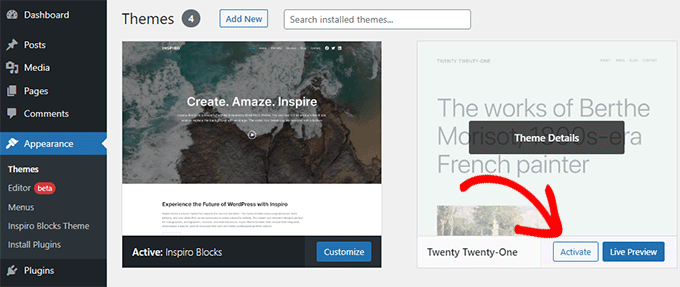
Se non avete installato un tema predefinito, potete fare clic sul pulsante “Aggiungi nuovo” in alto e installare un tema predefinito (Twenty Twenty-Three, Twenty Twenty-Two e così via).
Se non avete accesso all’area di amministrazione di WordPress, potete comunque passare a un tema predefinito.
È sufficiente collegarsi al proprio sito web WordPress utilizzando un client FTP e navigare nella cartella /wp-content/.
Fare clic con il pulsante destro del mouse per selezionare la cartella dei temi e scaricarla sul computer come backup.
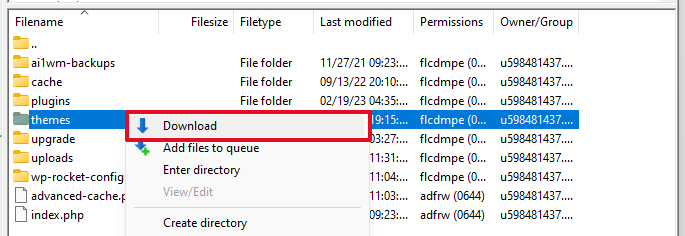
Successivamente, è necessario eliminare la cartella themes dal sito web. Una volta eliminata, creare una nuova cartella themes.
La nuova cartella dei temi sarà completamente vuota, il che significa che al momento non è stato installato alcun tema di WordPress.
Successivamente, è necessario visitare la directory dei temi di WordPress e scaricare un tema predefinito di WordPress sul computer.
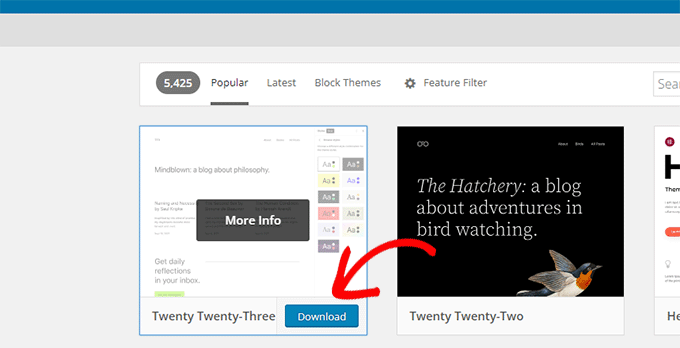
Il vostro browser scaricherà quindi il tema come file zip sul vostro computer.
Individuare il file sul computer e decomprimerlo. Gli utenti di Windows possono decomprimere il file facendo clic con il pulsante destro del mouse e selezionando “Estrai tutto”. Gli utenti Mac possono fare doppio clic sul file zip per estrarlo.
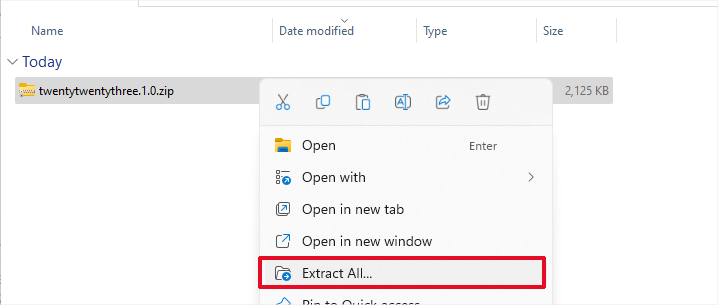
Ora vedrete una cartella contenente il vostro tema di WordPress.
Passare nuovamente al client FTP o al File Manager e caricare questa cartella nella cartella vuota dei temi.
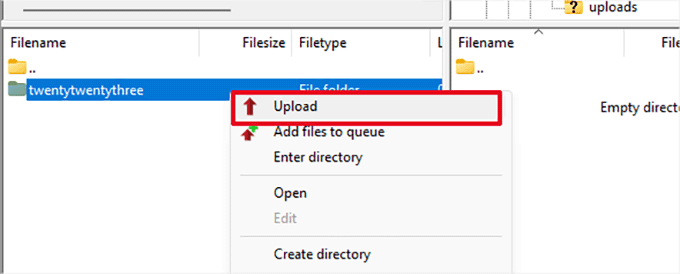
Una volta caricato, WordPress inizierà automaticamente a utilizzare il tema predefinito.
Ora è possibile visitare il sito web per verificare se l’errore del server interno è stato risolto.
Se non funziona, potete ricaricare i vostri temi WordPress dal backup o tornare al tema che stavate usando.
Non preoccupatevi. Ci sono ancora alcune cose che potete fare per risolvere l’errore.
Ricaricamento dei file del nucleo
Se le opzioni dei plugin e dei temi non hanno risolto l’errore interno del server, è opportuno ricaricare le cartelle /wp-admin/ e /wp-includes/ da una nuova installazione di WordPress.
Questa operazione NON rimuove le informazioni, ma può risolvere il problema nel caso in cui un file sia danneggiato.
Per prima cosa, è necessario visitare il sito web WordPress.org e fare clic sul pulsante “Download”.
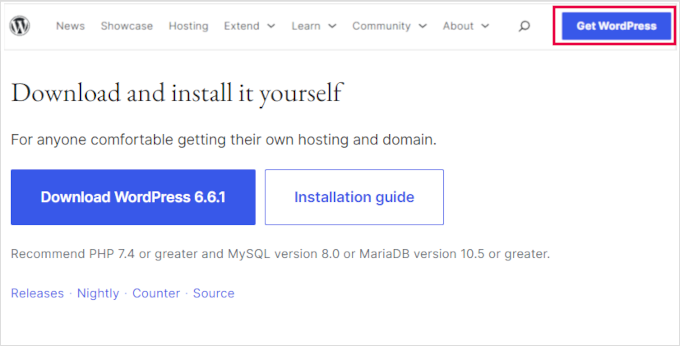
Questo scaricherà il file zip di WordPress sul vostro computer.
Procedere con l’estrazione del file zip. Al suo interno troverete una cartella wordpress.

Successivamente, è necessario collegarsi al proprio sito web WordPress utilizzando un client FTP.
Una volta collegati, accedere alla cartella principale del sito web. È la cartella che contiene le cartelle wp-admin, wp-includes e wp-content.
Nella colonna di sinistra, aprite la cartella WordPress sul vostro computer.
Ora è necessario selezionare tutti i file presenti nella cartella di wordpress e caricarli sul sito web.
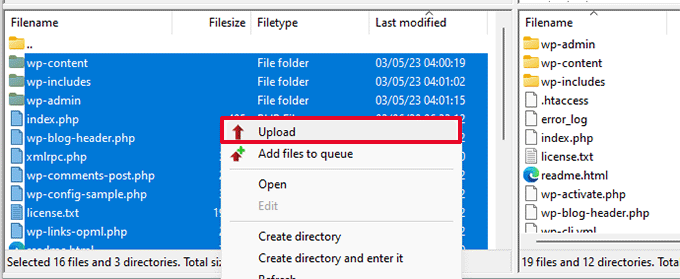
Il vostro client FTP trasferirà ora queste cartelle sul vostro server.
Verrà chiesto se si desidera sovrascrivere i file. Selezionare “Sovrascrivi”, quindi selezionare “Usa sempre questa azione” e selezionare la casella di controllo “Applica solo alla coda corrente”.
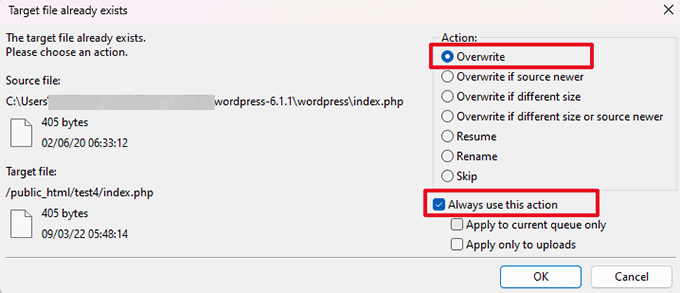
Il vostro client FTP sostituirà ora i vecchi file di WordPress con nuove copie fresche.
Se i file di WordPress sono stati danneggiati, questo passaggio risolverà l’errore interno del server.
Abilitare i log di debug in WordPress
WordPress è dotato di un sistema integrato per mantenere i log per il debug.
È possibile attivarlo utilizzando il plugin WP Debugging. Per maggiori dettagli, consultate la nostra guida su come installare un plugin di WordPress.
Una volta attivato, il plugin attiva i log di debug sul vostro sito web WordPress.
Se non avete accesso all’area di amministrazione del vostro sito WordPress, potete attivare il debug aggiungendo il seguente codice al file wp-config.php:
1 2 | define( 'WP_DEBUG', true);define( 'WP_DEBUG_LOG', true); |
Una volta attivati i log di debug, è possibile visualizzarli utilizzando un client FTP e navigando alla cartella /wp-content/.
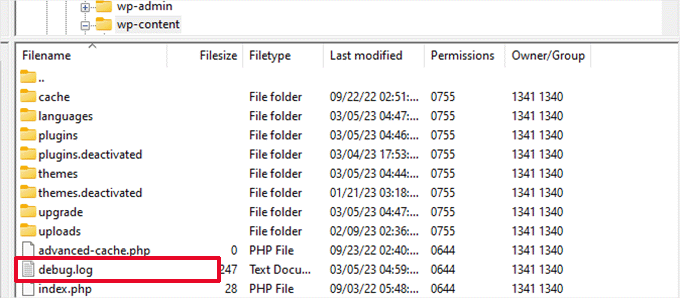
Il file di log di debug può essere aperto in un editor di testo e mostrerà un elenco di errori e avvisi che si verificano sul sito web.
Alcuni errori e avvisi possono essere incidenti innocui che non devono essere risolti. Tuttavia, se il vostro sito web presenta un errore interno del server, questi possono indicarvi la giusta direzione.
Chiedete al vostro fornitore di hosting
Se tutti i metodi non riescono a risolvere l’errore interno del server sul vostro sito web, allora è il momento di chiedere aiuto.
Contattare il team di assistenza del web hosting, che sarà in grado di controllare i registri del server e individuare la causa principale dell’errore.
Se volete continuare a risolvere i problemi da soli, consultate la nostra guida definitiva alla risoluzione dei problemi di WordPress per i principianti.
Video tutorial
Se questo articolo vi è piaciuto, iscrivetevi al nostro canale YouTube per le esercitazioni video su WordPress. Potete trovarci anche su Twitter e Facebook.





Kim
Thanks. It was a corrupted .htaccess file.
Friedemann Wetter
nothing but “Re-uploading Core Files” solved it!
I used a copy of a similar page that had no problems!
Thanks!
Jeffrey Hayes
Your article did help me solve the issue. The problem seem to start when I tried to add new pages and/or post. After reading your article I first went into my file manager in my hosting control panel and tired to change the name of htaccess file but file manager would not allow me to do this so I went back into wordpress and deactivated ALL my plugins and then I could add pages and post with no error messages so I then reactivated one plugin at a time and each would add post/page until I found the plugin that was causing the problem so WP is running great again thanks to you, I am very new to WP as I always develop my websites in Dreamweaver.
WPBeginner Support
Hi Jaffery,
Glad to hear that you find WPBeginner helpful. Don’t forget to follow us on Facebook for more WordPress tips and tutorials.
Don’t forget to follow us on Facebook for more WordPress tips and tutorials.
Admin
Diego
I was having trouble with this and i tried every solution here.
Nothing worked , then i looked in the folder where wp-config , wp-mail is and i found a file named erro_log.
I looked and found two of my pages inside the theme was giving error i just upload again via ftp the files and Boom!
All working again.
Sophie
Thanks for posting this. Your reply solved my problem as well. I had forgotten a ‘,’ in php file.
Thank you for saving me the time of deactivating all of my plugins!
Aathira
Thank you for saving my life.
Dave Sumner
inre: Re-uploading the core files includes/admin… am I overwriting the existing files or do I have do something first like re-name the old files before ftp’ing the new core files in. I’ve searched everywhere, but I don’t think I’ve seen an answer stated definitively on that.
Thanks.
Rico Bravo
I went through every step and I couldn’t fix the error. So, I deleted the child theme and re-set the permalinks to Post name – It worked. Thanks for the tutorial…
Aseem Rastogi
Deactivating all plugins worked for me..
thank you
Fredy pandia
thanks wpbeginner
you really made my day
changging .httaccess to the basic help my site up and run again
basic wordpress .httacess
# BEGIN WordPress
RewriteEngine On
RewriteBase /
RewriteRule ^index\.php$ – [L]
RewriteCond %{REQUEST_FILENAME} !-f
RewriteCond %{REQUEST_FILENAME} !-d
RewriteRule . /index.php [L]
# END WordPress
John
I renamed the Plugins folder to Plugins.de
i logged into my site, it listed all my plugins but said they were not present.
I logged out of my site.
I then renamed the folder back to Plugins. I logged into my site, all the plugins were there but not activated. i activated the plugins 1 at a time until i found the corrupted plugin. i then deleted that plugin, reloaded it, activated it and now all works perfectly.
Joshua lynch
Hello, I am new to a company and they had a third party create and run their wordpress, now ive somehow accidentally managed to change the URL of the site to something else rather that what was purchased and added to the business website using the url from a host, I think they use Fast host, but I get a 500 internal error now and I cannot log into the account and when you go to the web page it come up without a theme or anythning. Please Advise as I need this sitem up and running again asap!
Frank
You saved my life! Thanks.
Daniel
I renamed my htacces and it worked but my problem is it toke back the Maximum upload file size which increased before to its default plz help
David
I had an issue where none of these things worked for me. For some reason, whenever I clicked “save” in the general settings or when clicking “save” in the permalinks settings, it would send me into a 500 server error loop. The only way to fix this was to upload a new “clean” version of an .htaccess file I had from another site running a similar setup. Same host, etc. Clicking save would trigger a change in the .htaccess file and basically corrupt it. In speaking with Bluehost tech support (like the 7th or 8th time) I finally found a stud tech support and he addressed the issue by disabling something called the “endurance cache plugin.” If you are on Bluehost and face the same issue, have your support try this. It could save you both hours!
João Nunes
Thanks a lot, it solved my problem.
Will
Deactivating plugins and then Activating them solved it for me thanks. One tip for you video is to slow down on each item I had to pause and rewind like 3 times lol
cr_mck
Thank you so much for posting this help tutorial. It was a corrupt plugin that caused the problem. I changed the plugin folder name and managed to get back in and turn them back on one-by-one.
Jose Cabral
Re-uploading Core Files solved my issues
Maurice
I was updating a plugin and then I got the 500 internal server error. I watched the video above and I am a internet technology moron. In the video the author is on a screen I have no idea how to get to or what it even is. Please help.
Maurice
Kat
Useful but since I’m such a newbie and still learning WordPress, I am stuck. I can’t even seem to log in because of the 500 internal server error. Do you know what I should do?
Shuaib
you save my life
Carlos
Thanks a lot for this. It helped me solve the issue.
Neneh
Deactivating the plugins worked for me, thanks
Atin
i tried all the above solutions but none worked correctly .
Here is my situtation;
1. frontend not working (I need solution for this)
2. backend login works fine
James
Same problem here. Clean WP installation works fine. Restoring DB and files from local server to hosting – front page’s blank screen, admin panel is available.
Have you already solved your problem, Atin?
Kate
Have you tried resaving the Permalink structure under Settings? This can help restore a corrupted .htaccess file, which I’ve found causes a lot of those broken-front-end, working-back-end problems.
Charlotte
I’m the opposite, front end working, haven’t even been able to get back end working at all since making it live through wp-admin! Tried everything!!
Ang
GREAT! Thanks x all, your save my day!
Tulay
Thanks! you re the hero of the day and saved me! have an awesome day just for that!
Mac
Thanks a lot it works for me. You save my day! Cheers!
Lindsay
Thank you for this article! It helped me resolve issues with my site quickly rather than having to rely on tech support that takes days!
SJ
Thank you,
In my case, I found the theme is causing the error. After deleting, it works.
How to fix this, This is a premium theme which can’t be downloaded from wordpress directly.
This theme is perfectly working on my another site which is controlled by vestacp.
But, This server is managed by CWP. So, Centos web panel security may be the reason for this http 500 error??
Please help
Thanks
Celian
Thanks you very much for theses advices, it worked perfectly !
Larry Halpern
After updating WordPress to 4.7.2, I’m getting the 404 error (“The requested URL / was not found on this server”). My host said to go to the settings tab and saved them – no luck. I’ve deactivated the plug-ins – no luck. This hasn’t happened in 7 years. Any thoughts?
WPBeginner Support
Hi Larry,
Please follow the steps in WordPress troubleshooting guide.
Admin
Kris
Just to say thanks for this information, concise and fortunately for me the first step fixed it!
Andrea
Ignore my last comment. I figured out what I did. I now just am unsure on how to figure out which plugin it was that messed me up. lol
Andrea
I just followed these steps as I had an Error 500. I can now get back into WordPress admin (thank you), but none of my plug-ins are back. I could add them all again, but I have NO IDEA what I had. Any advice on how to get them back? This happened once before and it all came back fine when I deactivated. I’m a complete novice, so I’m guessing I hit something wrong. Thanks.
Mohak M
I encountered this error while restoring via a backupbuddy zip file. I uploaded the zip and importbuddy.php script in the root directory via FileZilla and ran the script. However, during the process, i got this error. Any idea how to fix this issue?
Thanks.
JPS Nagi
Thank you ! Thank you ! Thank you ! Thank you !
My hosting company was not helpful. I am just a simple guy who was happy with WordPress. The tech support on the phone was annoyed, and rude.
Finally got this to work … it was the htaccess thing.
I need to find new hosting company … any recommendations ?
WPBeginner Support
Please take a look at our guide on how to choose the best WordPress hosting.
Admin
Med Toledo
Thanks a lot for this TIP, I did as suggested and wordked as a charm. I renamed the .htacces file, just wondering if that file is needed or the server generates a new one?
WPBeginner Support
WordPress regenerates it automatically if it doesn’t find one. You can also regenerate it by visit Settings » Permalinks page in your WordPress admin area. Simply click on the save changes button without making any changes.
Admin
Jimy Lincoln
Thank you very much for this video. It helped when my hosting company was not available.
Phoebe
I am getting the HTTP 500 error when I try to access the admin site. The site itself seems to be working as normal though. This has happened after I updated to WP 4.7. Any suggestions?
Scott
I just had this exact issue and here is how I solved it.
1. Rename the plugin folder via ftp. i.e. plugin-test.
2. Visit the website’s admin page
2.a. When prompted, update the database
3. Make sure you can go in and out of the sites admin page like normal.
4. Rename the plugin folder back to original name.
That fixed the issue for me.
Manjunath
Thanks! Its unbelievable post about fixing internal server error. I was frustrated about this error and finally fixed it by this post and i like all The posts written here.
Yulia
Thank you so much for such a simple and useful explanation!
Melissa
I am getting the http error 500 message when I try to log into the admin site and am unable to access it. The site itself works fine though. I was upgrading the site to the latest version of WP. Can anyone help?
Suzanne Turner
I’m unable to access the dashboard for my site so I don’t know how I can perform the above checks.
WPBeginner Support
Hi Suzanne,
Please see our guide on what to do when you are locked out of WordPress admin area.
Admin
rachel
Life saver thank you. Mine was caused by a plugin which I deleted from the hosting control panel and all was well again.
S.S.
Thanks so much for this article (and for all your great articles!) As a new wordpress developer, you just saved me hours of stressing!!
Ian Rhodes
I run several sites and have run into a strange problem. I can access one site, but not the admin. On another I can’t access the site or admin. Another site is unaffected.For the problem sites I get error 500.
When I spoke to my service provider, the weird thing is that the CAN access the login screen that I can’t.
I’ve tried your suggestions to no avail and am still unable to get to my dashboard
WPBeginner Support
Try our step by step WordPress troubleshooting guide to figure out what’s causing this issue.
Admin
nanda
i was add zipfile theme from my pc and insall……after loading its shows internal error …..please help me thank you
Ugyen Zangmo
It fixed my problem. Thank you so much
Dan
This would be helpful if I could get into the site to begin with, but that’s the problem I’m having. Unable to log in and getting a INTERNAL SERVER ERROR 500
Kira San
I think when the site exceeds the disk quota, this error will pop up.
Miruna B.
Hello,
Thanks for the article. After trying everything you suggested, I managed to get my site back up, however now it seems I am experiencing a new issue. I cannot install, download, update anything… it just says Unpacking or downloading and nothing happens.
Is there anything I can do?
Best!
Francesco Mazzini
Thanks! Really hopeful. I had a 500 Internal Server Error, spent a lot of time looking for solutions in the web, and at least you were the only one who gave the right answer. now it goes! The site is , showed only the home page and not the others, but reading your answers and applying them and now is on again. Great!
Thanks again!!!
WPBeginner Support
Hey Francesco,
Glad you found it helpful. You may also want to subscribe to our YouTube Channel for WordPress video tutorials.
Admin